From the very first day that you work with your horse, you must establish respect. He should be respectful of you and you should be respectful of him. It’s a two-way street. Respect is the foundation of control—without it, you won’t be able to control your horse and he won’t be any fun to be around.
There are two categories of respect: a safety category and a learning category. The safety category teaches you how to establish your personal space, which will keep you safe. The learning category is about how to earn the horse’s respect in order for him to learn what you’re teaching him. Before you can start to teach the horse anything, he must first respect you. In this lesson, you’re going to work on the first category—safety.
You Are Fragile
The first thing your horse has to understand when you begin your partnership is that you are fragile and he needs to be careful around you. I honestly don’t believe that most horses intend to hurt us. They just don’t realize that they’re bigger and stronger than us. Consider the weight difference between you and your horse. Your horse is roughly 10 times your weight. He’s in a 1,000-pound category and you’re in a 130- to 200-pound category.
A horse may not necessarily mean to hurt you, but because of his size, if he comes into contact with you, it can hurt. For example, when a horse kicks another horse in the belly what does that horse do? He grunts, walks 4 feet away and starts eating grass again like nothing ever happened. It doesn’t really bother him. But, if you get kicked in the ribs by a horse, you’re in the hospital for a week with seven broken ribs. It’s the same kick, but it means a lot more to you because you’re a smaller creature. Horses are a lot bigger than us humans. The safety part of respect is to say, “Listen, take care of me. I’m pretty fragile, so you can’t be biting me and kicking me or playing rough around me.”
When horses are out in the pasture together, do they bite and kick each other? Yes, especially young horses. They’re not trying to hurt each other; they’re just playing and practicing their dominance skills. When they do bite or kick each other, it doesn’t mean much because they’re evenly matched in size and weight. When a 1,000-pound animal tries to play with you, you come out on the wrong end of the deal.
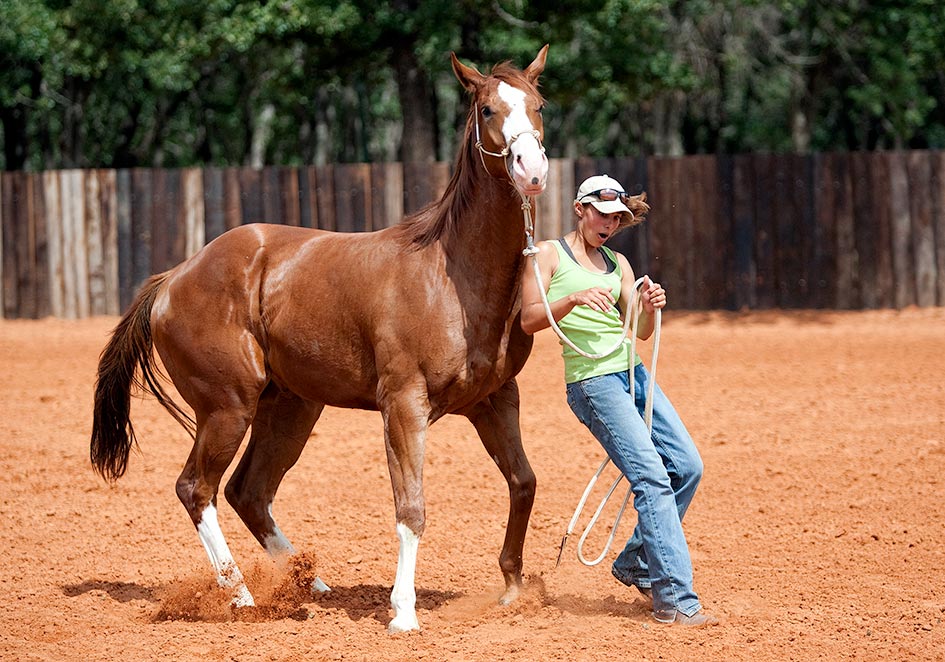
Most horses don’t intend to hurt humans. They just forget that they’re bigger and stronger than us.
An Invisible Protective Bubble
When focusing on the safety category of respect, you’ll work on establishing your personal hula hoop space. Your personal hula hoop space is a 4-foot circle that surrounds you and serves as your safety zone. When you are working with a horse, always imagine that there’s a 4-foot circle drawn around you—almost like an invisible electric fence. Unless you invite the horse into your space, he should keep a respectful safe distance from you. He should never come in unless you invite him in. Think of how you want your neighbors to treat you. You might like your neighbors, but you never want them to just barge into your house. You always want them to walk up to the door, knock and ask to come in. At that point, you can invite them in or you can ask them to come back at another time. You always want the option to turn them away.
You don’t want your horse to act like a nosy neighbor and barge into your space. Most injuries people suffer while working with horses occur because the horse was too close to them. They’ve gotten bitten, stepped on, kicked, etc. because the horse was entering their personal hula hoop space without permission. You can’t be injured if the horse is kept outside of that circle. A horse can’t bite you if he is 4 feet away from you; he can’t kick you if his hind legs don’t get any closer to you than 4 feet; and he can’t run over you if his chest is outside of your hula hoop space.
But don’t be fooled into thinking that only a disrespectful horse will hurt you. A fearful horse will hurt you just as fast. In fact, a horse that is scared is one of the most dangerous horses to be around because when a horse gets frightened, he doesn’t think straight. He’s relying solely on the reactive side of his brain, trying to survive the situation. A scared horse doesn’t intentionally try to hurt you, but can accidentally harm you in his attempt to escape the situation.
Think about a time when you’ve been around a frightened horse. Let’s say you were leading him in from the pasture and something scared him. When something frightens a horse, what does he try to do? He pushes into you and invades your personal hula hoop space. He tries to jump in your top pocket because he is looking to you for safety. Unfortunately, you’re a lot smaller and more fragile than a horse and eventually, you will get hurt. Any horse, including yours, can become frightened. By establishing your personal hula hoop space from the beginning, you’re teaching him that if he wants to have a heart attack and get scared, that’s fine with you. But he better do it outside of your personal hula hoop space.
The bottom line is that you want yourself to be safe and you want your horse to be safe, but in that order—you first and the horse second. You can’t train him if you’re dead. You have to survive the experience first and train the horse second. By establishing your personal hula hoop space, you’ll keep yourself safe while working with your horse and earning his respect. Your horse should only enter your personal space if you specifically invite him into it. Otherwise, he should keep a respectful, safe distance.
“ Your personal hula hoop space is a 4-foot circle that surrounds you and serves as your safety zone.”
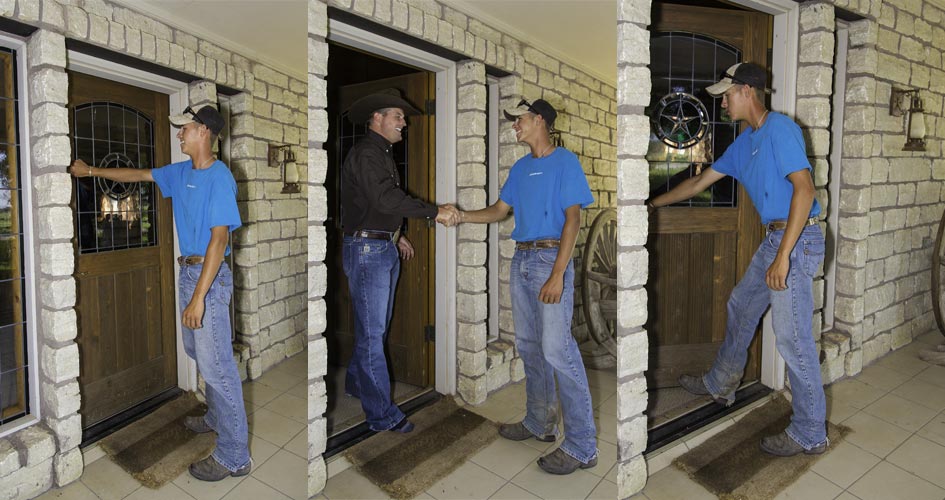
You want your horse to treat your hula hoop space like a polite neighbor who knocks on your door and waits to be invited in. You don’t want him to be a nosy neighbor who just barges in without an invite.
How to Establish Your Personal Hula Hoop Space
1. Trace a circle in the ground around you with the Handy Stick. Hold the Handy Stick out as far as you can reach and draw a circle around yourself. When you’re finished, you should be standing in the center of the circle, facing the horse. Hold the lead rope in one hand with enough slack in it so that you’re not pulling on the horse and hold the Handy Stick in your other hand. If you’re in a dirt arena, I recommend physically using the tip of the Handy Stick to draw a circle around you. That way, it’ll be very clear to you where your personal hula hoop space is. Even if the ground you’re working on won’t allow you to physically outline your hula hoop space, the act of tracing the circle around you will help you mentally picture your personal space.
If you find yourself having a really difficult time with this exercise and don’t have a dirt arena, buy a hula hoop and lay it on the ground and stand in the center of it. Anything inside that circle is your personal space. The horse should respect your space and not crowd into you.
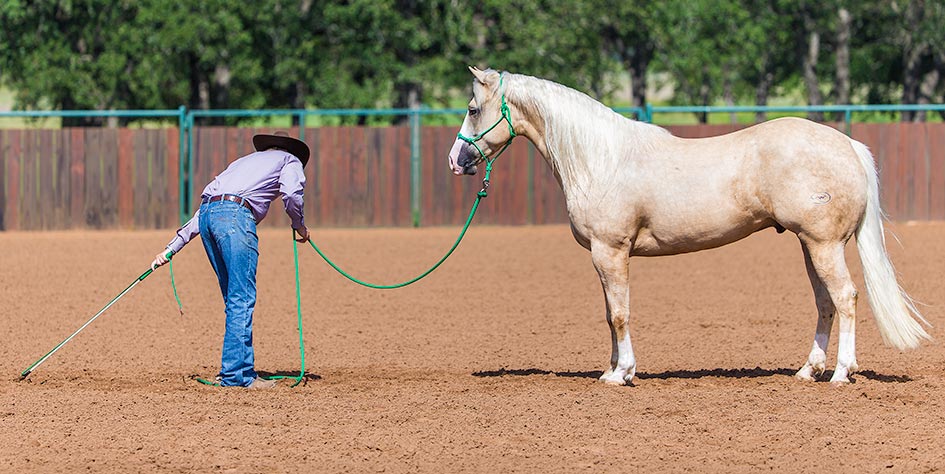
1. Trace a circle in the ground around you with the Handy Stick.
2. Keeping your feet as still as possible, ask the horse to back out of your space. If the horse is up close to you, tap him on the chest with the stick, if necessary, march your elbows and wiggle the lead rope to get him to back away from you. When he’s taken a step or two, tap the lead rope with your stick to get him to back out of your space. Rhythmically tap the lead rope with the Handy Stick. Start by gently tapping the rope—one, two, three, four. If he doesn’t step out of your space, then tap the rope harder—One, Two, Three, Four—and keep increasing the pressure until he steps out of your space. If he is really belligerent, you may have to whack the clip or his nose with the stick. Do what you have to do to get the job done. The entire time, he should keep his eyes on you as he backs out of your space.
If you can touch any part of the horse with the stick when you extend your arm, that means he’s inside your personal space and you need to back him out of it. Back him away from you until you can no longer reach him with the stick.
As he backs out of your space, don’t let him turn away from you. He needs to keep his eyes and attention on you the entire time. If his attention starts to wander, bump on the lead rope until he gives you his attention again and looks at you with two eyes. As soon as he looks at you, stop bumping on the lead rope.
As you back the horse out of your space, keep your feet still. He’s the one that has to move his feet out of your space. Remember the number one rule of horsemanship: Whoever moves first loses. Don’t let it be you!
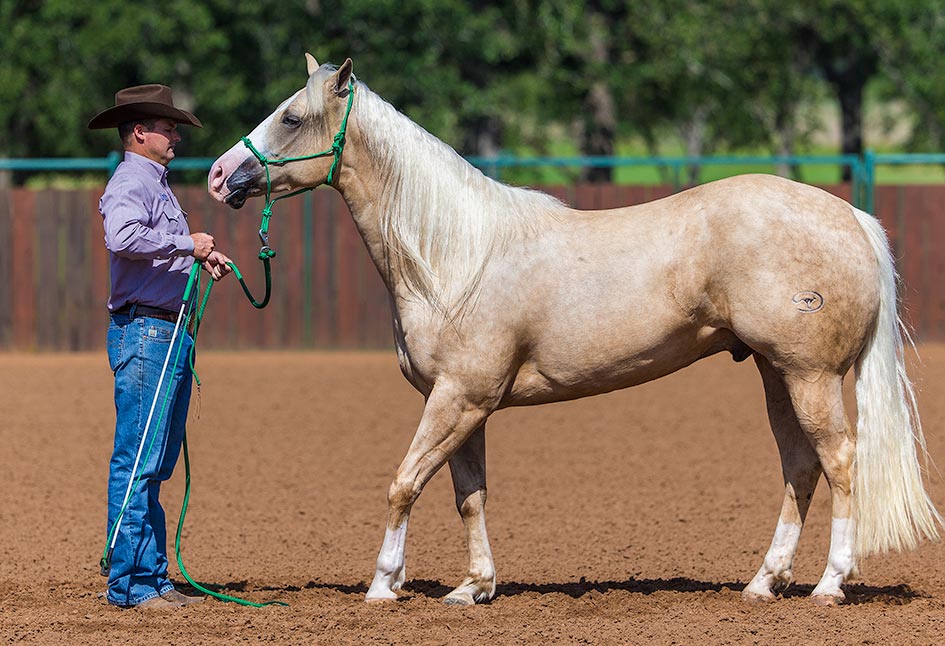
2. Keeping your feet as still as possible, ask the horse to back out of your space.
3. Once the horse is out of your space and looking at you with two eyes, release the pressure and leave him alone. If you can touch any part of the horse with the Handy Stick while your arm is stretched out, he is too close, and you’re in danger of getting hurt if he should react. Always play it safe until you know you have the horse’s attention and respect, you can control his feet and you can trust him before you invite him into your space. Never assume a horse is safe; always make him prove it to you.
I’m not telling you that you can’t ever love on your horse or rub him, of course you can. But only after you’ve earned his respect and you invite him into your space. Right now the horse should only come forward if you invite him up to you, but before you start inviting him into your space, you’re going to take him through several groundwork exercises to ensure that you have his respect and can control his feet. If he comes forward on his own, tap him away with the stick. Make it clear to him that he needs to respect your space.
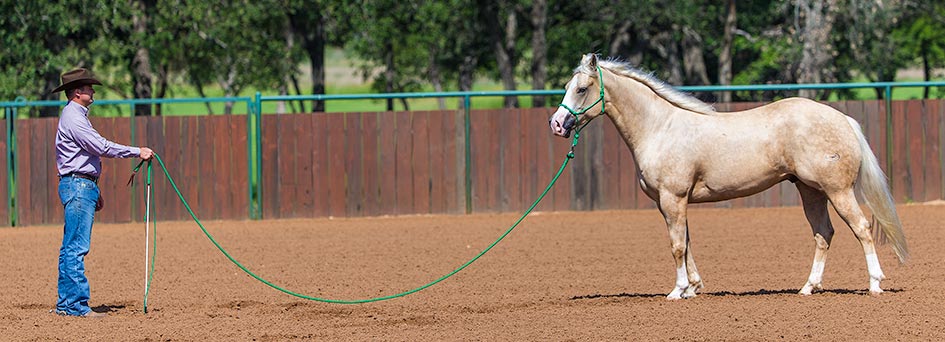
3. Once the horse is out of your space and looking at you with two eyes, release the pressure and leave him alone.
4. Every time the horse takes his eyes off you, bump the lead rope until he focuses on you again. Horses can only think about one thing at a time. They’re either thinking about you and giving you their respect, or they’re thinking about their buddies out in the pasture or their next meal. Anytime the horse is with you, his attention must be with you.
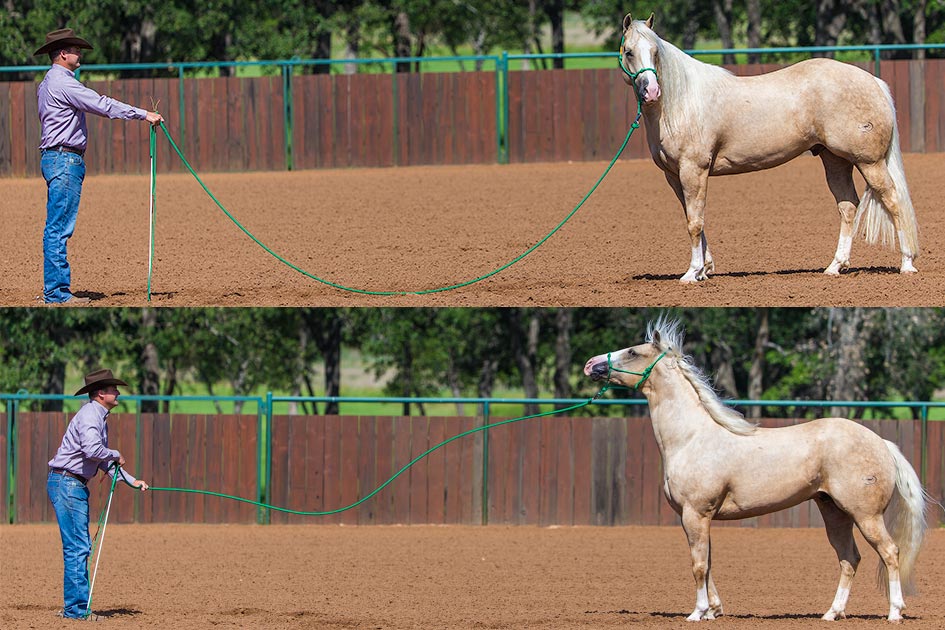
4. Every time the horse takes his eyes off you, bump the lead rope until he focuses on you again.
5. If the horse steps forward and comes into your space, immediately back him up away from you. Once you back your horse out of your personal space, he needs to stay out of it unless you invite him back in. So anytime he creeps toward you, even if he just shuffles forward an inch, back him away from you. With horses that have never been taught to respect their human’s personal space, you’ll have to repeat this step several times before the horse understands that he’s not to come toward you until you allow him to. This happens a lot at clinics. People will back their horses away from them and then almost immediately the horse barges right back into their space. Enforce your safety zone.
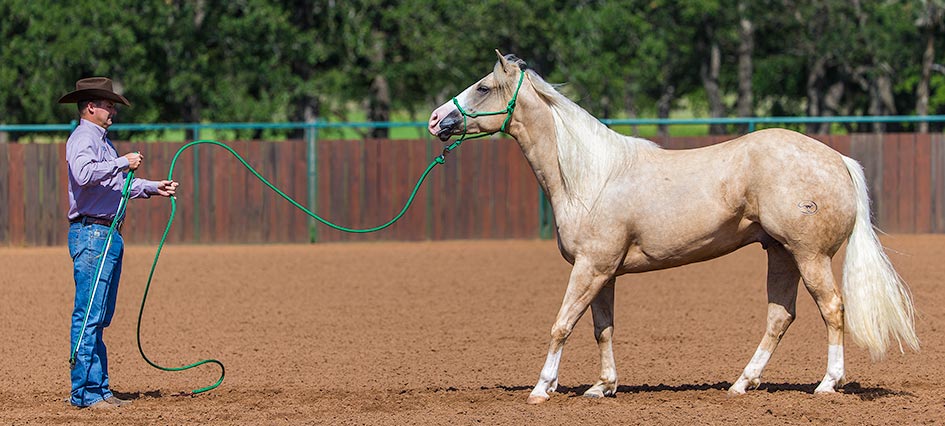
5. If the horse steps forward and comes into your space, immediately back him up away from you.
6. After letting the horse rest outside of your hula hoop space, and when he’s no longer attempting to barge into it, invite him to come up to you. Lean forward and comb the rope, using one hand and then the other, to ask him to walk toward you. When he reaches you, rub his face with your hands. This is like you saying, “I appreciate you being polite and waiting for me to allow you into my space; now let me reward you.”
It’s important that you comb the rope with your hands so that you’re gently encouraging the horse to approach you. If you just pull on the lead rope, he’s likely to brace his feet and lean against the pressure.
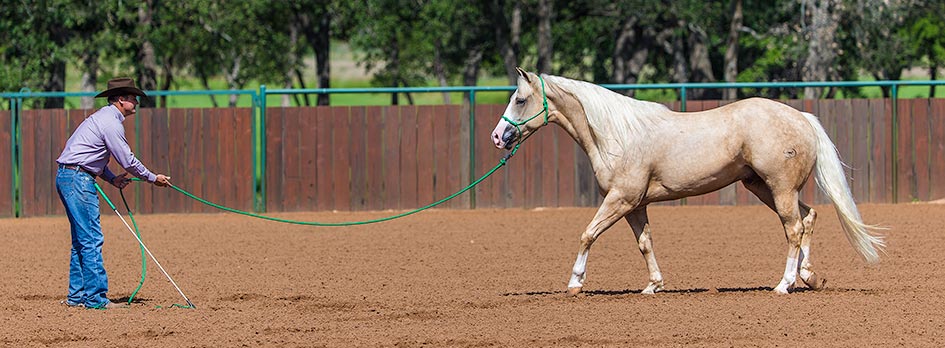
6. After letting the horse rest outside of your hula hoop space, and when he’s no longer attempting to barge into it, invite him to come up to you.
7. After a few minutes of rubbing the horse, back him out of your space again, being conscious not to move your feet. If at any point while you’re rubbing the horse while he’s in your space he pushes on you, immediately back him away from you. Practice the exercise until the horse stays out of your personal space unless you invite him to come up to you. The safest horse in the world is a respectful horse.
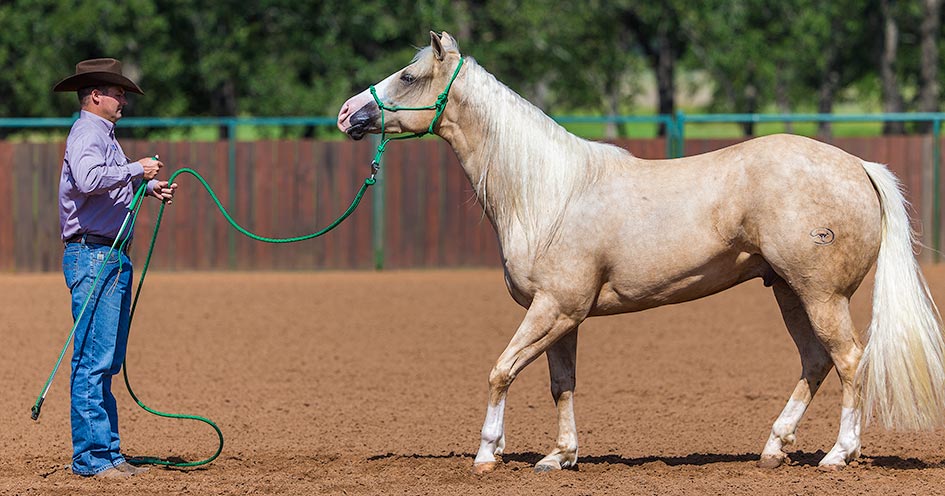
7. After a few minutes of rubbing the horse, back him out of your space again, being conscious not to move your feet.
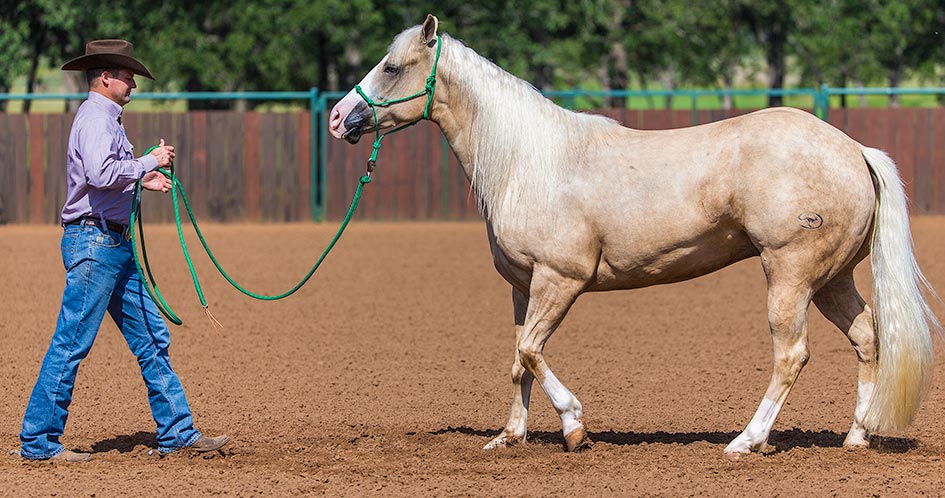
Do not move your feet when you back the horse up. You should stand completely still.
Handler Mistakes:
Being ineffective.
When you ask the horse to back out of your space, do what you have to do to get the job done. Start by gently tapping the lead rope with the Handy Stick—one, two, three, four. If he ignores you, increase the pressure and tap the rope harder—One, Two, Three, Four. If he still ignores you, then tap the rope even harder—ONE, TWO, THREE, FOUR. And keep increasing the pressure until he takes a step out of your space. If the horse has been taught to be pushy and disrespectful, you might have to whack the clip or his nose with the Handy Stick. Do what you have to do to get the job done. Do it as easy as possible, but as firm as necessary.
Following the horse.
The entire time that you’re practicing this exercise, your feet shouldn’t move. Remember, whoever moves first loses. Horses establish dominance by being able to move each other’s feet. If you allow your horse to move you around, he’ll gain control. You need to earn his respect and be an effective leader for him. You’ll do that by proving to him that you can move his feet forwards, backwards, left and right anytime you want. The more you can move his feet, the more respect you’ll get. That all starts with this exercise. When he starts backing up away from you, keep your feet still and stay inside your hula hoop.
Not drawing a circle in the ground.
I recommend drawing a circle on the ground if you can so that you can see exactly where your hula hoop is. Anytime you can touch the horse with the stick or he enters into your space, back him out of it.
Horse Problems:
Horse creeps into your space.
The horse is only allowed in your hula hoop space if you invite him in. Every time he invades your personal space, back him out of it. Start with low pressure and then gradually increase the pressure until he steps away from you. Once you can no longer touch him with the stick, leave him alone. Make the right thing (staying out of your space) easy and the wrong thing (pushing into you) difficult.
Horse won’t give you two eyes.
The entire time that you are working with your horse, he should be looking at you with two eyes. Two eyes are always better than two heels. If I want to teach you something, I need you to give me your eyes and your attention. If you look out the window and stare at the people walking on the street, all the information I am teaching you will go in one ear and out the other. But if you have your eyes on me, there’s a chance that what I’m teaching you will sink into your head. When you don’t have a horse’s attention and respect, he won’t remember anything you teach him. On the other hand, the more attention and respect he gives you, the more he’ll remember. It’s that simple.
Troubleshooting:
The horse won’t back out of your space.
Some horses have been allowed to ignore humans and push them around for so long that you have to really get after them in order for them to take you seriously when you ask them to back out of your space. At clinics, this is typically the 15-year-old gelding that’s been pushing his 5’2″ owner around for so long that when she taps him with the stick, he just stares back at her laughing.
You may have to whack your horse aggressively on the chest or the nose with the stick to get him to back up. Remember, do what you have to do to get the job done. Do it as easy as possible, but as firm as necessary. But no matter how hard you have to whack the horse to get him to move out of your space, always start gently and finish gently. As long as you always start gently, the horse will eventually learn how to back away when you lightly tap the rope, but if you always ask him to back away by just whacking him as hard as you can with the stick, that’s what you’ll always have to do.
Horses never get any lighter than the first amount of pressure you apply to them. So even if you know the horse isn’t going to back out of your space when you gently tap the rope, always start by asking him with light pressure. With repetition, he’ll learn to back away as soon as you make a suggestion.
Success Tip:
Tap with rhythm.
When you back the horse out of your space, count out loud to yourself as you tap him with the Handy Stick. With each set of numbers, increase the pressure. Start with low energy, then move to medium energy and then go to high energy if necessary. Don’t nag at the horse with half-hearted taps. Remember, one good whack is better than a thousand little taps. Be effective. Do what you have to do to get the job done. Do it as easy as possible, but as firm as necessary.
Points to Remember
- Your personal hula hoop space is a 4-foot circle that surrounds you.
- Your horse is only allowed into your personal space if you invite him in.
- In order to have your horse’s attention and respect, he needs to be looking at you with two eyes.
- Anytime he invades your space, back him out of it.
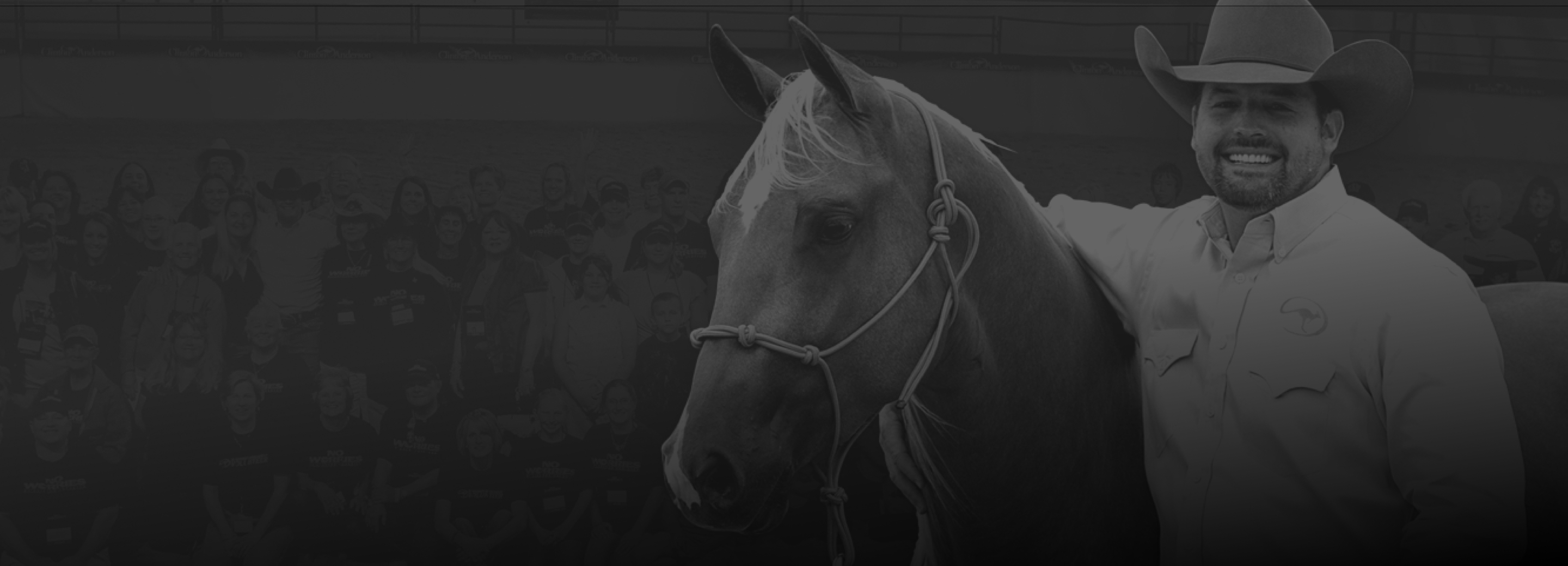
Want To Learn More? SIGN UP FOR OUR LOYALTY PROGRAM
Master your horsemanship training through Clinton’s step-by-step method videos by joining the No Worries Club today. Becoming a club member ensures you get VIP pricing on all of Clinton’s must-have training tools and resources. Plus, you’ll enjoy all the phenomenal benefits that come with club membership!



